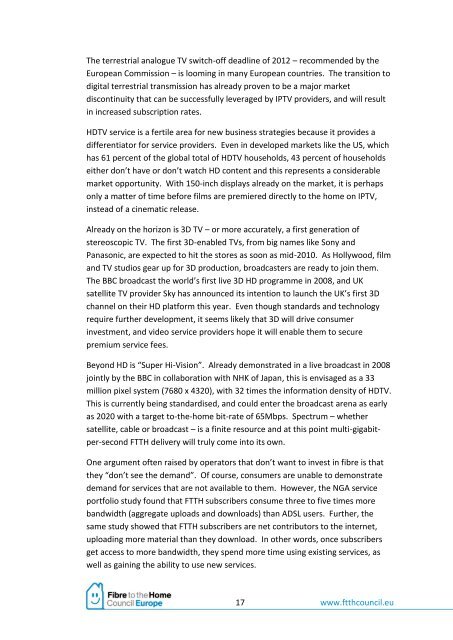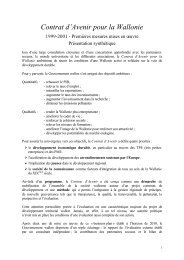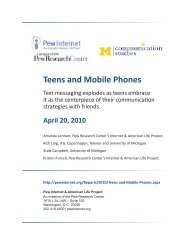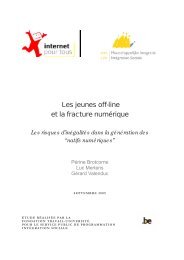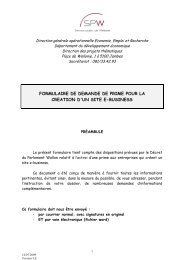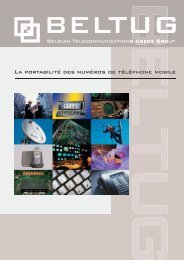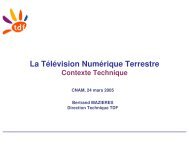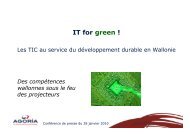You also want an ePaper? Increase the reach of your titles
YUMPU automatically turns print PDFs into web optimized ePapers that Google loves.
The terrestrial analogue TV switch-off deadline of 2012 – recommended by the<br />
European Commission – is looming in many European countries. The transition to<br />
digital terrestrial transmission has already proven to <strong>be</strong> a major market<br />
discontinuity that can <strong>be</strong> successfully leveraged by IPTV providers, and will result<br />
in increased subscription rates.<br />
HDTV service is a fertile area for new business strategies <strong>be</strong>cause it provides a<br />
differentiator for service providers. Even in developed markets like the US, which<br />
has 61 percent of the global total of HDTV households, 43 percent of households<br />
either don’t have or don’t watch HD content and this represents a considerable<br />
market opportunity. With 150-inch displays already on the market, it is perhaps<br />
only a matter of time <strong>be</strong>fore films are premiered directly to the home on IPTV,<br />
instead of a cinematic release.<br />
Already on the horizon is 3D TV – or more accurately, a first generation of<br />
stereoscopic TV. The first 3D-enabled TVs, from big names like Sony and<br />
Panasonic, are expected to hit the stores as soon as mid-2010. As Hollywood, film<br />
and TV studios gear up for 3D production, broadcasters are ready to join them.<br />
The BBC broadcast the world’s first live 3D HD programme in 2008, and UK<br />
satellite TV provider Sky has announced its intention to launch the UK’s first 3D<br />
channel on their HD platform this year. Even though standards and technology<br />
require further development, it seems likely that 3D will drive consumer<br />
investment, and video service providers hope it will enable them to secure<br />
premium service fees.<br />
Beyond HD is “Super Hi-Vision”. Already demonstrated in a live broadcast in 2008<br />
jointly by the BBC in collaboration with NHK of Japan, this is envisaged as a 33<br />
million pixel system (7680 x 4320), with 32 times the information density of HDTV.<br />
This is currently <strong>be</strong>ing standardised, and could enter the broadcast arena as early<br />
as 2020 with a target to-the-home bit-rate of 65Mbps. Spectrum – whether<br />
satellite, cable or broadcast – is a finite resource and at this point multi-gigabitper-second<br />
<strong>FTTH</strong> delivery will truly come into its own.<br />
One argument often raised by operators that don’t want to invest in fibre is that<br />
they “don’t see the demand”. Of course, consumers are unable to demonstrate<br />
demand for services that are not available to them. However, the NGA service<br />
portfolio study found that <strong>FTTH</strong> subscri<strong>be</strong>rs consume three to five times more<br />
bandwidth (aggregate uploads and downloads) than ADSL users. Further, the<br />
same study showed that <strong>FTTH</strong> subscri<strong>be</strong>rs are net contributors to the internet,<br />
uploading more material than they download. In other words, once subscri<strong>be</strong>rs<br />
get access to more bandwidth, they spend more time using existing services, as<br />
well as gaining the ability to use new services.<br />
17 www.ftthcouncil.eu


